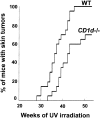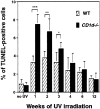Resistance of CD1d-/- mice to ultraviolet-induced skin cancer is associated with increased apoptosis
- PMID: 15331412
- PMCID: PMC1618602
- DOI: 10.1016/S0002-9440(10)63350-0
Resistance of CD1d-/- mice to ultraviolet-induced skin cancer is associated with increased apoptosis
Abstract
Inhibition of p53-induced epidermal apoptosis, generation of p53 mutations, and suppressor T cells are the critical events responsible for the induction and development of UV-induced skin cancers. Recently, we demonstrated that CD1d knockout mice were resistant to UV-induced immunosuppression, prompting us to further address the role of CD1d in regulating UV carcinogenesis. We, therefore, investigated the response of wild-type (WT) and CD1d-/- mice to UV carcinogenesis. We found that although 100% of WT mice developed skin tumors after 45 weeks of UV irradiation, only 60% of CD1d-/- mice developed skin tumors. Surprisingly, keratinocytes and fibroblasts from CD1d-/- mice were more sensitive to UV-induced apoptosis and persisted longer than cells derived from WT mice. In addition, epidermis and dermis taken from chronically UV-irradiated CD1d-/- mice harbored significantly fewer p53 mutations than WT mice. Our findings identify an unexpected and novel function for CD1d as a critical molecule regulating UV carcinogenesis, by inhibiting apoptosis to prevent elimination of potentially malignant keratinocytes and fibroblasts.
Figures







Similar articles
-
Inverse relationship between increased apoptosis and decreased skin cancer in UV-irradiated CD1d-/- mice.Photochem Photobiol. 2005 Jan-Feb;81(1):46-51. doi: 10.1562/2004-09-21-IR-322. Photochem Photobiol. 2005. PMID: 15496135
-
Epidermal Rac1 regulates the DNA damage response and protects from UV-light-induced keratinocyte apoptosis and skin carcinogenesis.Cell Death Dis. 2017 Mar 9;8(3):e2664. doi: 10.1038/cddis.2017.63. Cell Death Dis. 2017. PMID: 28277539 Free PMC article.
-
p53 protects against skin cancer induction by UV-B radiation.Oncogene. 1999 Jul 22;18(29):4247-53. doi: 10.1038/sj.onc.1202789. Oncogene. 1999. PMID: 10435637
-
p53 tumor suppressor gene: a critical molecular target for UV induction and prevention of skin cancer.Photochem Photobiol. 2008 Jan-Feb;84(1):55-62. doi: 10.1111/j.1751-1097.2007.00213.x. Photochem Photobiol. 2008. PMID: 18173701 Review.
-
Molecular aspects of ultraviolet radiation-induced apoptosis in the skin.J Cutan Med Surg. 2005 Dec;9(6):289-95. doi: 10.1007/s10227-005-0109-0. J Cutan Med Surg. 2005. PMID: 16699907 Review.
Cited by
-
Expression of CD1d in human scalp skin and hair follicles: hair cycle related alterations.J Clin Pathol. 2005 Dec;58(12):1278-82. doi: 10.1136/jcp.2005.027383. J Clin Pathol. 2005. PMID: 16311347 Free PMC article.
-
UVB-induced skin inflammation and cutaneous tissue injury is dependent on the MHC class I-like protein, CD1d.J Invest Dermatol. 2014 Jan;134(1):192-202. doi: 10.1038/jid.2013.300. Epub 2013 Jul 18. J Invest Dermatol. 2014. PMID: 23867896 Free PMC article.
-
CD1d gene is a target for a novel amplicon at 1q22-23.1 in human hepatocellular carcinoma.Mol Biol Rep. 2010 Jan;37(1):381-7. doi: 10.1007/s11033-009-9817-7. Mol Biol Rep. 2010. PMID: 19757161
-
The Role of the Immune System in Cutaneous Squamous Cell Carcinoma.Int J Mol Sci. 2019 Apr 24;20(8):2009. doi: 10.3390/ijms20082009. Int J Mol Sci. 2019. PMID: 31022866 Free PMC article. Review.
-
Roles and therapeutic potential of CD1d-Restricted NKT cells in inflammatory skin diseases.Front Immunol. 2022 Sep 2;13:979370. doi: 10.3389/fimmu.2022.979370. eCollection 2022. Front Immunol. 2022. PMID: 36119077 Free PMC article. Review.
References
-
- Gloster HM, Brodland DG. The epidemiology of skin cancer. Dermatol Surg. 1996;22:217–226. - PubMed
-
- Strom S. Epidemiology of basal and squamous cell carcinomas of the skin. Weber R, Miller M, Goepfert H, editors. Baltimore: Williams and Wilkins,; Basal and Squamous Cell Skin Cancers of the Head and Neck. 1996:pp 1–7.
-
- Brash DE, Ziegler A, Jonason AS, Simon JA, Kunala S, Leffell DJ. Sunlight and sunburn in human skin cancer: p53, apoptosis, and tumor promotion. J Invest Dermatol Symp Proc. 1996;1:136–142. - PubMed
-
- Kanjilal S, Pierceall WE, Cummings KK, Kripke ML, Ananthaswamy HN. High frequency of p53 mutations in ultraviolet radiation-induced murine skin tumors: evidence for strand bias and tumor heterogeneity. Cancer Res. 1993;53:2961–2964. - PubMed
Publication types
MeSH terms
Substances
Grants and funding
LinkOut - more resources
Full Text Sources
Medical
Molecular Biology Databases
Research Materials
Miscellaneous

